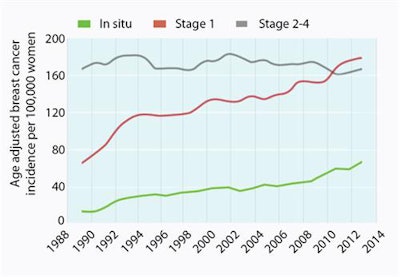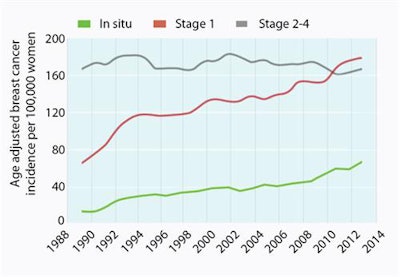
Peer review has, obviously, failed at BMJ. The authors of its breast screening study published on 5 December have completely misinterpreted their own data.
The facts are summarized in figure 3 belying their entire argument. When screening begins, a "prevalence peak" is expected, a sudden increase in the number of cancers detected.
 Trends in age adjusted breast cancer incidence by stage in women aged 50 or more in the Netherlands, 1989 to 2012.
Trends in age adjusted breast cancer incidence by stage in women aged 50 or more in the Netherlands, 1989 to 2012.The prevalence peak represents the palpable cancers that would have been diagnosed in the prevalence year, to which are added the cancers that could be palpated in that year but overlooked, to which are also added the cancers that are detected by screening mammography that would not become palpable for one to four years had there not been any screening.
Once the prevalence cancers are removed, the next time the women are screened (incidence screening) the test will find the cancers that reach the new level of detection (smaller due to mammography). This means the "incidence" of invasive cancers as women are repetitively screened should return to the rate that cancers were being detected in the absence of screening, but they will be at a smaller size. Unless the rate of "overdiagnosed" cancers (assuming there are any) increases over time, the rate will return toward the prescreening rate.
However, statistics from Autier et al (specifically figure 3) show the rate of invasive cancers continued to increase after the start of the screening program. This means the underlying rate of invasive breast cancers kept increasing. If this were not the case, then the rate of invasive cancers should be a flat line.
If there had been no effect on the rate of advanced cancers, then they too should have increased in parallel to the rate of invasive cancers (increasing proportionally). Given that the rate of invasive cancers continued to increase after the start of the screening program, but the rate of advanced cancers did not, this means the percent of women presenting with advanced cancers has, in fact, declined dramatically, contradicting the authors' claims.
Based on figure 3 it would appear the rate of invasive cancers doubled from 80/100,000 to over 160/100,000 between 1989 and 2012. If there had been no decline in the percent of women with advanced cancers, the rate of these cancers should also have doubled from 160 to 320/100,000 over the same period, but instead it was only 160/100,000, which is a relative decline of 50%.
The authors have simply not understood their own data.
Dr. Daniel Kopans is from Massachusetts General Hospital, Boston, U.S.
The comments and observations expressed herein do not necessarily reflect the opinions of AuntMinnieEurope.com, nor should they be construed as an endorsement or admonishment of any particular vendor, analyst, industry consultant, or consulting group.



















